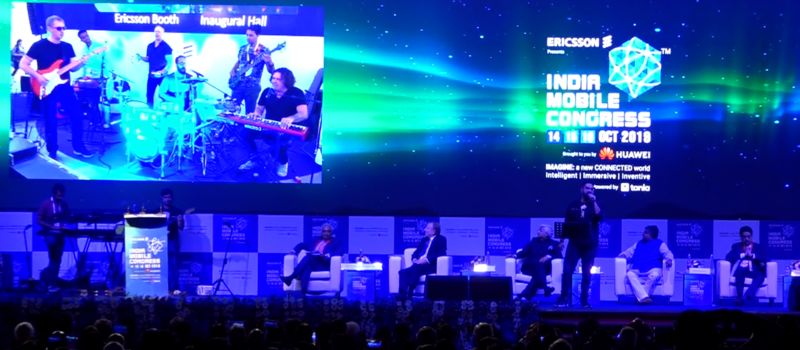In a first for India, Ericsson (NASDAQ: ERIC) and Airtel today enabled a 5G powered ‘Connected Music’ performance during the inauguration of the India Mobile Congress (IMC) 2019. The demonstration involved connecting two parts of a musical performance using a live 5G network and presenting it as one, for live audiences at both locations. One half of the performance had the singer and music composer, Siddharth Shankar Mahadevan perform ‘Jai Ho’ from the film ‘Slum Dog Millionaire’, whilst a Swedish band played at the Ericsson booth, about 100 meters away.
The ultra-low latency of the 5G network powered the connected music showcase at the IMC. This remote music collaboration in real-time is a boon for the performing art industry as it helps eliminate travel time and the costs that limit collaboration, performance, practice and learning. It also increases productivity for professionals in the music industry, including producers, event organizers and teachers. The performance highlights how 5G can transform our interaction with the arts and opens new opportunities for industries.
Nunzio Mirtillo, Head of Ericsson South East Asia, Oceania and India stated,
“We have been studying the impact 5G technology will have on industries across the world. This Connected Music demonstration is a fine example of benefits that 5G can bring to performing arts. It brings art and music closer to audiences.”
Nunzio further added,
“Ericsson has been the first to deploy live 5G networks across 4 continents. We are committed to sharing our live 5G deployment experience and learnings with the Indian telecom operators and other key stakeholders as the country gets ready for 5G. This includes working with our partners, such as Airtel, on 5G use cases.”
Table of Contents
More details on Ericsson’s 5G showcase at IMC 2019
5G Connected Ambulance
5G will enable new real-time communication services, like remote touch that will enable remote movement and control in real-time. This is a significant change and will potentially facilitate a global shift from real-time communication to real-time interaction. This demo showcases a real-life application of real-time communications in the health care industry, enabled by adding a data channel to IMS, alongside voice, video communication and text channels. A doctor from a hospital performs an ultrasound scan remotely on a patient who is in an ambulance. The doctor will be assisted by a paramedic in the ambulance who will be wearing a connected glove with haptic feedback. This will allow the doctor to control the paramedic’s hand remotely and thus conduct a remote ultrasound procedure in real-time with live video communication. This is the next step of evolving today’s VoLTE service combining it with 5G capabilities.
5G enabled Immersive Sports
The combination of 5G, augmented reality and virtual reality supports completely new user experiences. Service providers can utilize these capabilities to develop new innovative service offerings – and drive revenue growth. In this demo, we show new immersive experiences, brought to life through a live sports event. We let consumers step into the driver’s seat, taking control of their own digital sports experience.
Fixed Wireless Access
Up to 50% of the world’s population is still waiting for reliable broadband access. Fixed Wireless Access is an economical alternative to fibre. Together with enhanced mobile broadband, FWA is one of the early use cases of 5G. It is a wireless solution where end-customers subscribe to services that are complementing fixed alternatives such as fibre, cable or xDSL that has to deliver ‘solid data rate’ services in terms of capacity, availability and throughput (QoS). This is different from the mobile broadband network, where mobile data is best-effort by default as subscribers freely move around between cells. Consequently, dimensioning parameters will be different with less focus on peak speeds and more on average cell throughputs. Technically it is already feasible today to offer high enough data throughput rates to match fixed broadband alternatives.
Private LTE Network
A private network is comprised of 3rd Generation Partnership Project (3GPP) products using the same technologies developed for public networks. Private networks are scaled down to be deployable at the premises of enterprises, organizations and governments, for their industry-specific data and communication needs. They offer dedicated resources, fully under enterprise control. Only authorized devices/users can use network resources.
Private networks fulfil critical capabilities to interconnect people, machines, vehicles, sensors and other devices. A private network is currently based on LTE with ensured compatibility and readiness for 5G. The LTE technology delivers the best performance and speeds available today. 5G opens for further enhancements with higher bandwidth, both uplink and downlink, shorter latency and flexible resource allocation.
So, guys, do you think that real-life 5g services will come in sooner than expected? Do let us know your thoughts in the comments section below!
Keep visiting for more such awesome posts, internet tips, gadget reviews, and remember we cover,
“Everything under the Sun!”
Follow Inspire2rise on Twitter. | Follow Inspire2rise on Facebook. | Follow Inspire2rise on YouTube.



